
Skye Bioscience (NASDAQ: SKYE) is a micro-cap pharmaceutical company that is striving to become the next big thing in the weight loss drug space. The massive success of glucagon-like peptide-1 (GLP-1) agonist drugs sold by Eli Lilly (NYSE: LLY) and Novo Nordisk (NYSE: NVO) has prompted Wall Street analysts to place high expectations on Skye Bioscience.
Currently, Skye’s average price target sits at over $18 per share. With shares trading at under $4 right now, this target implies that Skye’s shares could rise north of 350%. I’ll dive into the specifics of the medicine Skye is working on, as well as the obstacles between the company and reaching these lofty expectations.
Nimacimab: A Better Weight Loss Treatment?
Skye isn’t working on a GLP-1 agonist drug. Its main drug is nimacimab, which acts as a peripheral cannabinoid receptor 1 (CB1) inhibitor. The drug is currently in Phase 2 of Food and Drug Administration (FDA) trials.
Reading through Skye’s documents, I identified three main potential benefits of its drug. First, it works through a distinct mechanism compared to GLP-1 agonists. This means that it could be used in combination with GLP-1s to possibly enhance weight loss or simply offer an alternative to these drugs.
Second, and one reason why someone might choose a CB1 drug for weight loss is the potential for the drug not to come with the same negative side effects as GLP-1s. GLP-1s have been found to have gastrointestinal adverse effects on patients. These include nausea, vomiting, and other effects. Between 40% and 70% of patients develop these symptoms; however, some research has found it to be up to 85% of patients.
These side effects tend to go away quickly; however, they may be a large reason why many people stop taking the drugs. Somewhere between 33% and 66% of people stop treatment within the first year. This gives significant credence to the idea that Skye’s medicine could become highly popular if it significantly reduces these negative side effects.
The last reason relates to the history of CB1 inhibitors. Back in 2006, the CB1 drug Accomplia was approved in the European Union to treat obesity. However, the drug crashed and burned due to the serious side effects, including depression and suicidal ideation.
Researchers believe this is because the drug entered the brain. The “peripheral” classification of Skye’s drug means it is designed not to enter the brain and only affect peripheral body tissue. Through this, Skye believes that its drug can mitigate these negative psychiatric effects.
Comparing Skye’s and Novo Nordisk’s CB1 Trial Results
Thus far, nimacimab has had some promising results regarding side effects. The Phase 1 trial for nonalcoholic fatty liver disease found that less than 5% of patients had gastrointestinal side effects. Additionally, researchers did not observe any adverse psychiatric effects. The company plans to release interim Phase 2 data for the treatment of obesity in Q2 2025 and final data in Q4 2025. Data will show the effects of the drug on its own as well as in conjunction with Wegovy.
Recently, Novo released Phase 2 results for its CB1 drug monlunabant. Researchers found the drug had “mild to moderate neuropsychiatric side effects." However, it did achieve 6.4% weight loss after 16 weeks.
Skye sees this news as positive. It supports that CB1 drugs can induce weight loss. But it also shows why Skye's drug could be better at reducing its harmful psychiatric effects. This is because monlunabant is not a peripheral CB1 inhibitor. So, the drug does enter the brain, purportedly causing the psychiatric effects.
Nimacimab’s Potential Drawbacks and What to Watch For
The main potential drawback of nimacimab is it may be less effective in treating weight loss. It appears that Skye is only targeting 8% weight loss after 26 weeks with just nimacimab. This would be significantly less weight loss than tirzepatide, Eli Lilly’s GLP-1 over that period. Depending on the dose, tirzepatide showed between around 12% and 16% weight loss after that period. A much lower percentage of weight loss could hurt nimacimab's potential sales.
Due to this, the results that look at its weight loss when combined with Wegovy may be more interesting, especially if they are significantly able to reduce gastrointestinal adverse events. These results should have huge implications for Skye’s stock price; however, betting on them is a risky proposition. After all, only 12% of drugs that enter FDA trials ever get approved.














